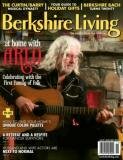
DANCE REVIEW: Kyle Abraham/Abraham.In.Motion at Jacob's Pillow
Dance
JACOB’S PILLOW
Doris Duke Theater
Kyle Abraham/Abraham.In.Motion
August 11-15, 2010
Doris Duke Theater
Kyle Abraham/Abraham.In.Motion
August 11-15, 2010
 Program:
Program:
Op. 1, world premiere
Inventing Pookie Jenkins (2006)
The Radio Show (2010)
Inventing Pookie Jenkins (2006)
The Radio Show (2010)
Review by Seth Rogovoy
(BECKET, Mass., August 11, 2010) – Kyle Abraham is still only in his early thirties, and his company is only in its sixth year, but already he has established a unique style and vocabulary, as well as a reputation for his highly personal approach, as seen in the program running this weekend in the Doris Duke Theatre at Jacob’s Pillow Dance.
That program includes Inventing Pookie Jenkins, a solo piece that Abraham created for himself, set to music by Dizzee Rascal. The piece, which at its premiere in 2006 announced the arrival of a new creative force in New York dance, features the Pittsburgh native as a homeboy in drag equally at ease in the languages of ballet, modern dance, and hip-hop, referencing Martha Graham (the slicing arms), Michel Fokine (The Dying Swan), and Michael Jackson (the crotch grab).
Abraham danced the number with a naked torso and flowing white skirt. At first we see him with his muscular back to the audience – an odd figure, with an optical illusion that makes him seem legless. Police sirens and gunshots seemingly wake him from his reverie, and he turns around and slowly stands up, and his character changes – he’s no longer a bystander but he’s the man the cops have been looking for, and he stumbles backwards as the gunshots pierce his torso. Abraham dances with his abdominals, rippling and undulating, as he’s pushed backwards by the force of the police bullets.
A boombox sits on the floor, and Abraham hoists it on his shoulders and his personality transforms into that of a gangbanger – his balletic arm slices now take on the character of hip-hop, and we see how much information gestures can convey, even in an untrained dancer (or, we see that the semiotics of the street convey as much or more than art-dance). Abraham abstracts popping and locking, as the MC of the music repeats, “People are gonna respect me.” Abraham breaks the fourth wall and walks up and down the aisle greeting dancegoers in character.
 The evening opened with a new work, Op. 1, inspired by the photography of Eadweard Muybridge. The number for six dancers, choreographed to an ambient-industrical score by Ryoji Ikeda, was danced behind a transparent scrim that allowed for animation projections to frame the stop-start action of the dancers like a photograph, as well as adding effects such as blur or more representative lines and cross-hatchings suggestive of a subway grate.
The evening opened with a new work, Op. 1, inspired by the photography of Eadweard Muybridge. The number for six dancers, choreographed to an ambient-industrical score by Ryoji Ikeda, was danced behind a transparent scrim that allowed for animation projections to frame the stop-start action of the dancers like a photograph, as well as adding effects such as blur or more representative lines and cross-hatchings suggestive of a subway grate.
As in all his dances, Op. 1 is rooted on the floor – not just weighted, but literally, as dancers spend a lot of time lying on the floor or assuming horizontal positions, with angled joints (elbows and knees), in wrestling and football positions. At one point, women take off their shirts and lie down with men in languour, and then suddenly get up and retreat, as if this was a conjugal visit in a prison.
 The evening’s centerpiece is The Radio Show, an hour-long work about memory and loss and the power of music to instill nostalgia and transport the listener to another time and place. Begun and ended by Abraham, the piece was otherwise danced by six of his corps dancers, all of whom were remarkable specimens as individuals and as dancers who have incorporated Abraham’s unique movement style. The piece could probably benefit from some editing and tightening, but it was evocative of the lost era of radio, when listeners established close relationships with station hosts on whom they could rely to play the latest hits, rather than talk only about themselves and their own inflated opinions.
The evening’s centerpiece is The Radio Show, an hour-long work about memory and loss and the power of music to instill nostalgia and transport the listener to another time and place. Begun and ended by Abraham, the piece was otherwise danced by six of his corps dancers, all of whom were remarkable specimens as individuals and as dancers who have incorporated Abraham’s unique movement style. The piece could probably benefit from some editing and tightening, but it was evocative of the lost era of radio, when listeners established close relationships with station hosts on whom they could rely to play the latest hits, rather than talk only about themselves and their own inflated opinions.
It was terrific to see Abraham given such an extended platform on which to showcase his new and recent work, as he will undoubtedly evolve into a force to be reckoned with in the contemporary dance world.
Seth Rogovoy is Berkshire Living’s award-winning cultural critic and editor-in-chief.
Bookmark/Search this post with:

 Delicious
Delicious Digg
Digg StumbleUpon
StumbleUpon Propeller
Propeller Reddit
Reddit Magnoliacom
Magnoliacom Newsvine
Newsvine Technorati
Technorati
